Of the 17 major works of stained glass in the church, the Annunciation window offers the timeliest focus for Advent, the first season of the church year and a period of preparation for the Coming of Christ.
The Annunciation story can be found in the first chapter of the Gospel according to St. Luke. The angel Gabriel appears to the Virgin Mary and informs her she has been chosen by God to be the mother of Jesus.
Since the window is not signed or dated, the artist must unfortunately remain without credit for his masterful interpretation of the Virgin’s initial reaction to Gabriel’s hailing her as one who is “highly favored” and “blessed among women.” St. Luke describes this astounding moment thusly,
And when she saw him, she was troubled at his saying, and cast in her mind what manner of salutation this should be.
Such details of expression, subtleties of shading and modeling of figures in the window were achieved by painting. The painted glass was then fired, during which time the paint was fused onto the glass. Most, if not all, of the church windows were created predominantly by this method. However, many of St. Mary’s windows also contain pieces of stained glass which, technically speaking, is glass made by adding metallic oxides that produce color during the glass manufacturing process. Although each method described thus far calls for a specific protocol, the term “stained glass” can be used also in a general sense to refer to glass that is made either way.
In addition to his fairly realistic rendering of the Virgin, the anonymous creator of the Annunciation window draws on a set of symbols and conventions that had evolved through the ages into a rich, distinctly Christian iconography.
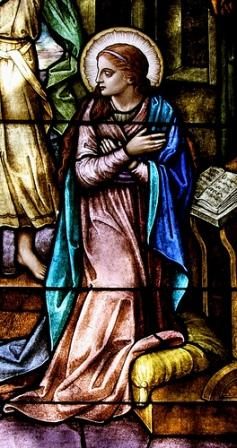
For example, the Virgin’s blue mantel is in keeping with the long standing tradition of using blue in association with St. Mary. Depiction of her kneeling at prayer or during her daily devotions – with a prayer book -- is common in Annunciation art.
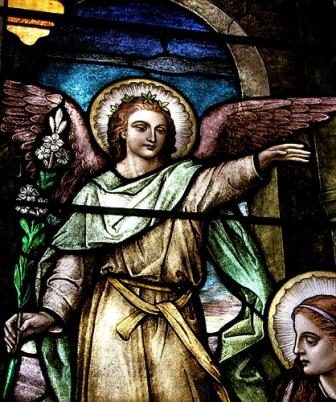
The lily is a standard symbol for St. Mary. However, the flower is also emblematic of Gabriel. Often in Annunciation scenes, the angel holds a stalk of lilies, as is the case in the Annunciation window at St. Mary’s. Sometimes lilies are shown arranged in a vase to suggest the purity of the Virgin, who is a vessel about to be filled.
Placement of figures in an architectural setting, likely inspired by Roman painting, was a hallmark of even the earliest medieval manuscript illuminations. In the St. Mary’s window, Gabriel stands in an archway that leads from the outside to the interior space where the Virgin kneels. To her left – almost lost in deep shadow – are rows of arches.
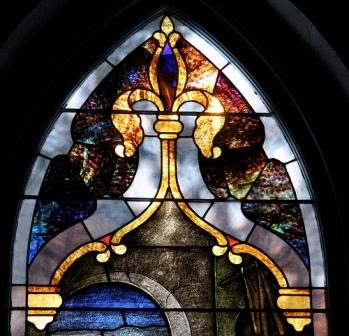
Also, the top of the window is painted with the suggestion of a Gothic arch, whose “keystone” is a fleur-de-lis, a stylized bouquet of three lilies (one standing upright flanked by two arched to opposite sides). The fleur-de-lis is also a symbol of St. Mary. Since several other windows at St. Mary’s reveal similar treatment, the fleur-de-lis “keystone” becomes a unifying visual element in the church.
Arches or some manner of small architectural niches along the bottom of a painting can be found in Byzantine and Early Italian Renaissance painting to frame representations of the four evangelists (the Gospel writers), various other saints or patrons. However, in the St. Mary’s Annunciation window the artist left the niches empty and almost obscured by the dedication, In Loving Memory of /T.H. Haynie/ R.I.P.
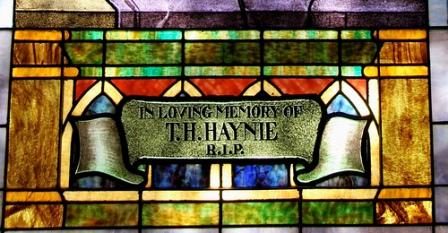
Thomas Hoxey Haynie, one of St. Mary’s founding fathers, was born in the Republic of Texas and moved to Lampasas about 1868. Since the Travis County native came to Lampasas at such an early date, it is quite possible that he was among the original “11 families and 3 individuals not in families” designated as members of the Episcopal mission at “Lampasas Springs” in the 1873 Diocesan Report.
In time Haynie emerged as a leader in both church and community. He was church treasurer the year St. Mary’s was completed and went on to serve as senior warden from 1901 to about 1912. He was also a lay reader for many years. His contributions to the community at large included service as Postmaster of Lampasas, Lampasas County Commissioner and Tax Assessor-Collector.
The window was given by Haynie’s daughter, Kate, wife of C.D. Stokes, a prominent wool merchant of early Lampasas. Since the window’s provenance is presently lacking, perhaps the best estimate is that it was made between Haynie’s death in 1917 and Mrs. Stokes’ death in 1930.
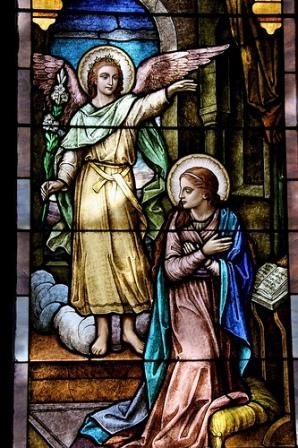
Today three generations of Haynie’s descendants are active in the church. Charlotte Haynie, his great granddaughter, is an altar guild member of longstanding. Her daughter, Tulisha Carson, is presently a lector, Eucharistic minister, Director of the Episcopal Youth Group, teacher of the Godly Play Sunday school class, member of the Altar Guild, assistant church treasurer and webmaster of St. Mary’s website.
Recently Mrs. Carson also served as Christian Education Director. In the mid 1990s she was Senior Warden, a position held by her great great grandfather Haynie a century ago.
Miss Abbie Carson, a sixth generation descendant of T.H. Haynie, is now an acolyte. Her brother Travis likewise was an acolyte during his youth.
Underscoring the prominence of the Haynie family in the life of St. Mary’s is the St. Cecelia window on the church’s north wall. It is dedicated to Mary S. (Mrs. L.R.) Carpenter, T.H. Haynie’s sister. It is said she long graced the church with her beautiful singing voice, hence the reference to Cecelia, the patron saint of music
Besides the Carpenter memorial on the north wall of the nave, St. Mary’s has a second St. Cecelia window. It is located on the east wall of the choir. But these windows are another story for another time.
© Jane McMillin